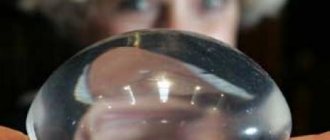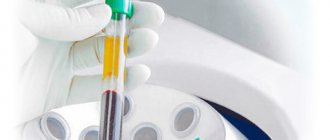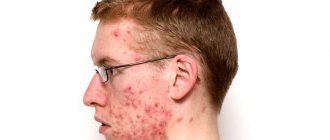Lipodystrophy, which is most often called lipoatrophy, refers to diseases from the group of metabolic disorders. It is characterized by abnormal growth of adipose tissue, which leads to its partial or complete loss. Disturbances in metabolic mechanisms as a result of this disease lead to liver steatosis, diabetes mellitus, etc. Complications that may arise as a result of this disease (kidney disease, acanthosis, etc.) significantly complicate the patient’s quality of life.
Lipodystrophy can be hereditary or acquired. Currently, lipodystrophy is most common among patients undergoing antiretoviral therapy prescribed for HIV infection.
Types of lipodystrophy
Congenital lipodystrophy
refers to a rare metabolic syndrome, which is characterized by a complete or partial absence of fatty tissue in the body. The disease is noticeable immediately at birth, since the baby does not have adipose tissue, except in the area of the scalp and soles of the feet.
Hereditary local lipodystrophy is a rare genetic disease that is transmitted as a dominant trait. It can occur in both women and men. At birth, this disease is not noticeable, but actively manifests itself in childhood and adolescence and is manifested by the accumulation of subcutaneous fat in the neck, face and limbs. Patients are characterized by the formation of a fatty hump between the shoulder blades.
Acquired lipodystrophy is an extremely rare form of the disease, most common in women. It appears in adolescence as a consequence of a viral infection. In almost all patients, the disease causes complications in the kidneys.
Acquired generalized lipodystrophy , a rare form in which there is loss of fat tissue throughout the body. As a rule, at birth the patient has a normal state of subcutaneous fat, but in childhood or adolescence there is a sharp loss of it. This disease can manifest itself after an infection: hepatitis, pneumonia, diphtheria, polio, chickenpox. As a rule, diabetes develops in parallel at the beginning of the disease.
Ring-shaped lipodystrophy is extremely rare and occurs mainly in women. Loss of adipose tissue occurs symmetrically, in the form of a ring, without inflammatory phenomena.
Localized lipodystrophy appears as a response to insulin administration, with loss of adipose tissue at the injection site.
HIV-associated lipodystrophy,
characteristic of patients who suffer from HIV infection.
What it is?
Lipodystrophy is a disorder of the formation of adipose tissue. The disease can be either congenital or appear against the background of other pathologies or the use of medications (for example, in the treatment of diabetes). The fat layer with lipodystrophy becomes altered.
If the disease is associated with insulin, then, as a rule, atrophy or lipodystrophy begins to appear at the injection sites. Eliminating cosmetic defects that have arisen is extremely problematic, so people who are undergoing therapy with insulin injections into adipose tissue should know how to prevent this pathology.
Important! If you have diabetes, treatment should be comprehensive. It is recommended to strive to reduce insulin dependence through proper diet and a healthy lifestyle.
More information about lipodystrophy in the video:
Symptoms of lipodystrophy
Since lipodystrophy is provoked by a variety of metabolic disorders, its symptoms can vary significantly. The main clinical manifestations of the disease are:
- General or partial loss of subcutaneous fat.
- Excessive deposition of fatty tissue in certain parts of the body, most often the face.
- Fat atrophy.
- In some cases, diabetes.
- Insulin resistance.
Diagnosis of lipodystrophy
Often, to establish a diagnosis, it is enough to evaluate the clinical picture of the disease. Laboratory tests may be ordered to determine blood glucose, triglyceride, and lipid levels. Differential diagnosis is necessary in relation to diseases such as HIV, cancer cachexia, Cushing's disease, anorexia nervosa, thyrotoxicosis, etc.
Types and features of pathology
The type of lipodystrophy is determined based on the nature of its origin. The primary disease is usually associated with congenital characteristics of the body. Acquired thinning and other defects of the fatty surface may be associated with the following pathologies:
- diabetes accompanied by insulin therapy;
- HIV;
- Barraquer-Simons syndrome.
Injecting drugs into the same place over a long period of time leads to changes. If at the same time a person experiences any other diabetic complications or suffers from liver diseases or acute intoxications, then the risk of developing lipodystrophy increases.
If lipodystrophy occurs against the background of diabetes, then a fairly serious threat to health appears. Atrophy can lead to poor absorption of insulin, which in turn will cause an increase in blood sugar. Hypertrophy can be complicated by suppuration, which will subsequently lead to gangrene.
Treatment of lipodystrophy
In modern medicine, there are currently no effective methods for treating this disease. Therapy is aimed at adjusting the patient’s diet and physical exercise. Although the role of diet in this disease is not so significant, it is a preventive measure in the progression of the disease.
The diet for patients with lipodystrophy has the same principles as for heart disease and diabetes, since it is quite often accompanied by cardiovascular diseases.
In recent years, in developed countries, cosmetic (plastic) methods for correcting lipodystrophy have begun to be used through the use of temporary or permanent fillers (medical silicone, collagen).
Reasons for appearance
In diabetes, tissue lipodystrophy develops due to improper use of insulin. The following factors can act as a trigger:
- use of old or poorly purified insulin preparations;
- reuse of a disposable syringe pen needle for injection;
- insulin dose higher than 10.1 units per day;
- no change in locations where injections are given.
READ ALSO: How to recognize insect bites, photos and examples
If injections are constantly given in one place on the abdomen without changing the location, then the fatty and subcutaneous tissue begins to change quickly. Compaction or, on the contrary, lipodystrophy occurs. At first, the lump feels like a small bump.
The likelihood of lipodystrophy also affects the presence of other chronic diseases. To carry out prevention, it is necessary to eliminate all provoking factors, achieve remission in the treatment of indolent diseases and prevent an increase in sugar.
Stages of development of gynoid lipodystrophy
In order to cope with this problem, it is necessary to study the stages of development of the disease. There are only four of them.
- At the first stage, changes in the skin are almost imperceptible: it is still smooth and without tubercles. If a woman looks closely at herself, she may notice a small accumulation of fat on her hips and abdomen. The reason for this is swelling of the adipose tissue.
- The second stage is manifested by the presence of tubercles, invisible without pressure. If you palpate these places, you can notice compactions, and sometimes even a loss of sensitivity in these areas.
- Gynoid lipodystrophy at the third stage is characterized by the presence of an “orange peel”, which can be easily detected. The skin feels uneven and bumpy to the touch. Pain sensitivity and susceptibility to temperature changes are reduced.
- The fourth stage is the most serious. The skin begins to take on a blue tint and feels cold and hard to the touch. There is even some pain in the cellulite area.
Treatment must take into account the stage of development of the disease. In each specific case, its own methods are selected.
Provoking factors
In addition to the reasons listed above, there are some other factors that cannot in themselves cause cellulite, but are quite capable of contributing to its development. The following can be named:
- heredity, that is, the characteristics of adipose tissue that are determined at the genetic level;
- small amount of fluid in the body;
- non-compliance with diet;
- passion for drugs for rapid weight loss;
- strict diets (at the moment of such stress, the body begins to convert almost all nutrients into fat);
- constant stress, and there is plenty of it in our lives.
All these factors, together with their causes, lead to disruption of microcirculation in those places where the accumulation of fat cells is greatest. This gradually leads to the death of some of the lipocytes, which begin to be replaced by connective tissue. It is this that causes the formation of tubercles and irregularities on the skin.
How to prevent the condition from getting worse
Diabetes is an extremely dangerous disease if adequate measures are not taken to combat it. Any diabetic should adhere to the following rules while fighting their illness:
- elimination of all symptoms and complications of high sugar;
- regular glucose monitoring;
- fight against chronic pathologies in the body;
- relief and prevention of dystrophies that interfere with injections.
First of all, you need to eliminate all third-party diseases. In diabetes, any pathological lesion is more severe than in a healthy person. You should also adjust your diet by eliminating all fast carbohydrates, fatty and fried foods.
Lipodystrophy may appear several years after the start of replacement therapy. If all the rules of prevention have been followed, but the complication still makes itself felt, then you should try to use only long-acting insulin, maximizing the interval between injections. This will slightly improve the condition of fatty skin tissue.
READ ALSO: A child has red bumps on his tongue: reasons for what it could be (photo)
You should regularly consult a specialist, especially if you need to somehow adjust the plan for combating the disease. The use of modern drugs and syringe pens for insulin allows us to avoid complications.
Alternating injection areas
Insulin injections are given in the stomach. To minimize harm to the fat layer, it is necessary to regularly alternate the areas of drug administration. Conventionally, the stomach can be divided into 4 squares. It is recommended to make each new injection 1 cm from the old one. The injection can also be carried out in the upper thigh and buttocks.
With proper planning and weekly rotation from one square to another, the subcutaneous tissue will have the opportunity to recover after injections. Thus, a collision with lipodystrophy will not occur even with extremely long-term treatment.
To understand whether the area has recovered after the injection, you should carefully palpate it. If there are no compactions or visual changes, and more than 1 week has passed, then you can inject again in the same place.
Does excess weight affect lipodystrophy?
Too much body fat and excess weight negatively affect the general condition of the body. The likelihood of developing tissue hypertrophy also increases. It is recommended to try to follow a diet and set the dosage of the hormone so that the weight gradually decreases and is within the normal body mass index.
A diabetic diet should be balanced. The body must receive all the necessary micro- and macroelements. To prevent glucose from jumping too much, you need to exclude all sweets from your diet. Preference is given to complex carbohydrates, salads and steamed foods.
Important! The diet should be prepared in consultation with a qualified physician. Errors in nutrition lead to a deterioration in overall health and the progression of diseases along with its complications.











